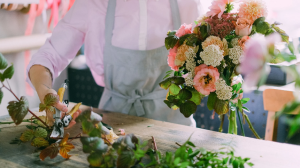Have you ever been captivated by the beauty and fragrance of a stunning floral arrangement? Do you find yourself drawn to the artistry and creativity that goes into creating these masterpieces? If so, then a career as a florist might be just what you’re looking for. This comprehensive guide will take you through the step-by-step process of becoming a florist. From understanding the role of a florist and exploring the potential earnings to learning the necessary skills and responsibilities, we’ve got you covered. Additionally, we’ll provide valuable tips for running a successful floristry business and highlight the benefits of pursuing this rewarding profession. So, if you have a passion for flowers and want to turn them into a thriving career, keep reading!
What is a Florist?

A florist is a person who sells and arranges flowers. A florist can be someone who works in a flower shop, or they can be someone who works out of their own home. Florists are passionate about flowers and use their creativity to arrange them in beautiful ways.
Most people think of a florist as someone who sells flowers, but there is so much more to it than that! A good florist knows how to care to choose the right type of flowers for each arrangement, and t, and how to make each arrangement unique. A florist also has a good eye for colour and design, which helps them create beautiful arrangements.
If you are considering becoming a florist, it is important to know that it takes more than just a love of flowers to be successful in this field. However, if you have a passion for flowers and arranging them in beautiful ways, then a career as a florist may be the perfect fit for you!
Do Florists Make Money?

In the United Kingdom, the average salary for a florist is £18,000 per year. However, this number can vary greatly depending on experience, location, and other factors.
The average florist in London earns £23,000 per year. Those in Manchester earn an average of £21,000 per year. And those in Edinburgh make an average of £19,500 per year.
However, it’s important to keep in mind that these are just averages. Some florists make much more than this, while others make less. It really depends on a variety of factors.
How to Become a Florist?

To become a florist in the UK, follow these steps:
- Gain floral knowledge and skills: Take courses or seek apprenticeships to learn about different types of flowers, floral arrangements, and care techniques.
- Obtain relevant qualifications: Consider acquiring formal qualifications such as a floristry diploma or certificate from recognized institutions like City & Guilds or the British Florist Association.
- Gain practical experience: Work at local flower shops, florists, or gardening centers to gain hands-on experience in the industry.
- Develop business skills: Learn about marketing, customer service, and running a small business
- Network with others in the industry: Attend floral events, join professional organizations, and connect with other florists to expand your knowledge and opportunities.
- Create a portfolio: Showcase your floral designs and arrangements by creating a portfolio that potential clients can review.
- Start your own business or join an established florist: Decide whether you want to open your own flower shop or join an existing one. Consider factors like location, competition, and target market.
- Stay updated with trends: Keep up with current floral trends and styles to provide unique and modern designs for your customers.
- Provide excellent customer service: Always prioritize the satisfaction of your customers by providing attentive and personalized service.
- Continuously improve and refine your skills: Attend workshops, take advanced courses, and stay updated with industry developments to enhance your floral expertise.
- Market your business effectively: Utilize social media, create a website, and collaborate with local businesses to promote your services and attract new customers.
- Adapt to seasonal demands: Be prepared to handle increased business during holidays and special occasions by planning ahead and stocking up on popular flowers.
- Foster relationships with suppliers: Maintain good relationships with flower wholesalers or vendors to ensure a steady supply of high-quality flowers at competitive prices.
- Embrace sustainable practices: Incorporate eco-friendly techniques and materials into your floral business to attract environmentally conscious customers.
- Seek feedback and learn from it: Regularly ask for feedback from your clients to understand their preferences and improve your offerings accordingly.
- Stay organized: Develop systems to manage inventory, orders, and appointments efficiently to avoid any confusion or mistakes.
- Hire and train a reliable team: As your business grows, consider hiring skilled florists and staff who share your passion for flowers and can provide exceptional service to your customers.
- Create a memorable brand: Develop a unique and cohesive brand identity that reflects your style and values, helping you stand out in the market.
- Offer customized floral arrangements: Cater to individual preferences by providing personalized and tailor-made floral designs for special occasions and events.
- Collaborate with event planners and wedding venues: Build strong partnerships with professionals in the event industry to expand your clientele and offer comprehensive floral services.
Job Responsibilities and Duties of a Florist

As a florist, your job responsibilities and duties will revolve around arranging and designing floral arrangements for various occasions such as weddings, funerals, and special events.
Additionally, you’ll provide customer service and assistance in selecting the right flowers and arrangements for their needs. Maintaining an inventory of fresh flowers and plants will be essential, ensuring they are properly cared for and displayed. You’ll also be responsible for managing the financial aspects of running a florist business, including pricing, invoicing, and budgeting.
Furthermore, keeping up with current trends in flower arranging and attending workshops or classes to improve your skills is crucial. Collaboration with other vendors and event planners to create cohesive designs for larger events will also be a part of your role.
Tips for Running a Successful Floristry Business

To run a successful floristry business, gaining experience and knowledge in the floral industry through training or apprenticeships is important. Developing a strong understanding of different flowers and their care requirements is crucial. Building relationships with suppliers ensures a steady and reliable source of fresh flowers.
Creating a unique and appealing floral style sets your business apart from competitors. Effective marketing through social media, local advertising, and collaborations with other businesses helps attract customers. Providing excellent customer service and consistently exceeding expectations builds a loyal customer base.
Benefits of Being a Florist

Being a florist offers numerous benefits that make it a rewarding career choice. One of the main advantages is the opportunity to unleash your creativity through stunning floral arrangements.
Additionally, florists often enjoy flexible work schedules, allowing for a better work-life balance. The job also brings immense satisfaction as you witness the joy on customers’ faces when they receive a beautiful bouquet. Furthermore, working with flowers allows you to stay connected with nature and bring its beauty indoors.
Lastly, being a florist opens up avenues for entrepreneurship, enabling many individuals to start their own businesses and be their own bosses.
Developing Skills in Floral Design

To develop your skills in floral design, consider taking classes or courses that teach the basics and help you refine your techniques. Gain hands-on experience by working as an apprentice or intern at a florist shop, allowing you to learn from experienced professionals. Practice creating various types of floral arrangements to expand your portfolio and stay updated on current trends and techniques through workshops and industry events. Enhance your credibility as a florist by obtaining certification or joining professional organizations.
Conclusion
Becoming a florist is a fulfilling career choice for those passionate about flowers and creativity. It offers the opportunity to bring joy to people’s lives through beautiful floral arrangements and designs. Pursuing a career as a florist requires dedication, hard work, and a love for all things floral. By following our step-by-step guide on how to become a florist, you can turn your passion into a successful business or career. From learning the basics of floral design to understanding the responsibilities and duties of a florist, we cover it all. If you’re ready to embark on this exciting journey, read our comprehensive guide on becoming a florist today.









